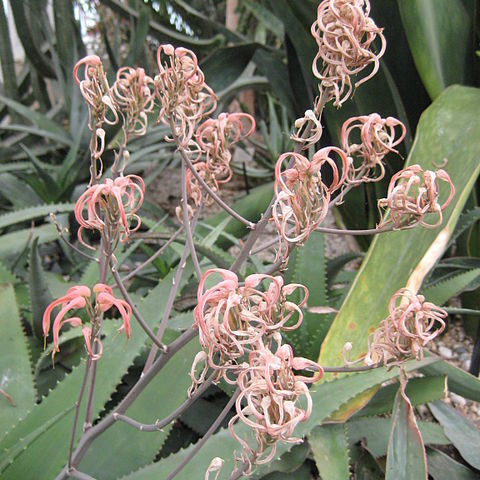Plants stemless or short-stemmed, 300-500 mm tall excluding inflorescence, forming large dense groups. Leaves ±20 per rosette, biconvex, 300-500 x 60-110 mm, grey-green to glaucous green, upper surface sometimes with few spots. Inflorescence a panicle 0.6-1.0 m tall; racemes capitate to cylindric, lax to sub-dense; bracts deltoid, 3.0-5.0 x 1.5-3.0 mm, 3-5-nerved. Flowers scarlet to brick-red, 18-40 mm long; outer segments free for 4-8 mm, inner segments free but dorsally adnate to outer; pedicels 19-25 mm long. Anthers exserted 1-2 mm. Ovary 6.0-7.0 x 2.0-2.5 mm, brownish green; style exserted 2-4 mm. Fruit ±21 x 12 mm.
Leaves in a dense rosette, erect, or spreading in shady habitats; lamina 30–60 cm long, 8–15 cm wide at the base, ovate-lanceolate, greyish-green to dark olive-green, with a bloom, often flushed with pinkish-red, obscurely lineate and occasionally sparsely spotted especially in young plants; margin cartilaginous with deltoid minutely brown-tipped teeth 1–3 mm long and 5–10(15) mm apart.
Perianth bright coral-pink or sometimes pale orange to yellow, 30–40 mm long, 7–9 mm in diameter across the ovary, narrowed above then curved and widening toward the mouth, tapering at the base, cylindric-trigonous; outer segments free for ± one-quarter, with tips slightly spreading.
Inflorescence erect to oblique, 0.5–1.5 m high; peduncle many-branched from low down, the lower branches often rebranching; branches spreading and usually curving upwards, subtended by deltoid scarious bracts 1–2.5 × 1 cm, with several small sterile bracts below each raceme.
Acaulescent or shortly caulescent, succulent herb, up to 500 mm tall. Leaves unspotted, 60-170 mm wide. Inflorescence a much-branched panicle (± 20 branches). Racemes lax, erect. Perianth trigonously indented, subclavate. Flowers scarlet to brick-red.
Racemes 5–15(20) × 8 cm, broadly cylindric, occasionally subcapitate, very laxly flowered or occasionally ± densely flowered; bracts 3–6 × 3.5 mm, ovate-acuminate, scarious; pedicels 15–25(30) mm long, spreading.
Perennial herb, suckering to form dense groups of plants, acaulescent or with a short stem.
Seeds c. 3 × 6.5 mm, blackish-brown with broad, pale buff, speckled wings.
Capsule stipitate for 1–2 mm, c. 20 × 10 mm, ovoid, greyish-brown.
Stamens and stigma slightly exserted.

